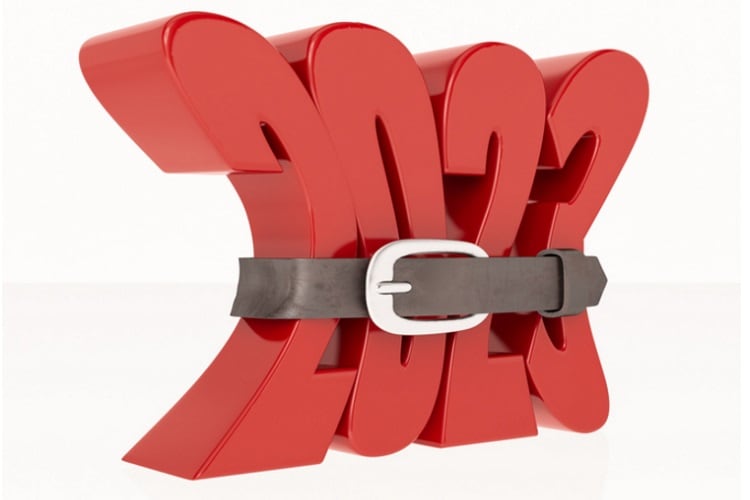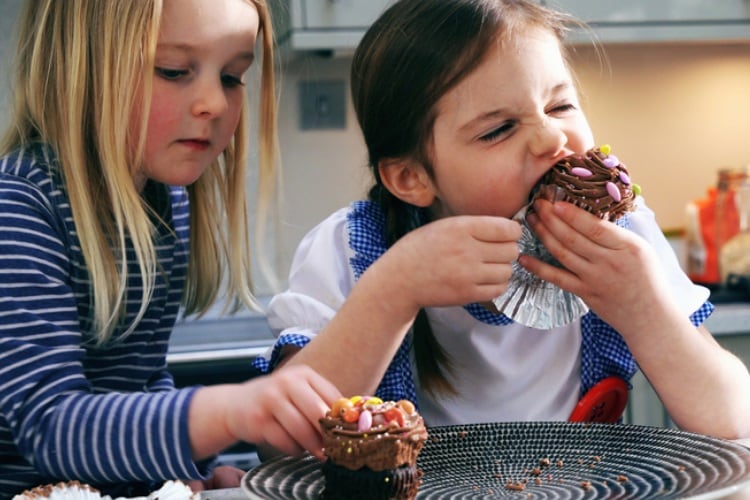Volatile energy prices and food costs pushed up even further by supply-side shortages means consumer confidence and spending has reached an all-time low across key European markets, reveals IRI. However, all is not lost and shoppers are taking control with the return of the packed lunches, ‘staying in’ and even buying out-of-date products at reduced prices.
Deteriorating disposable incomes
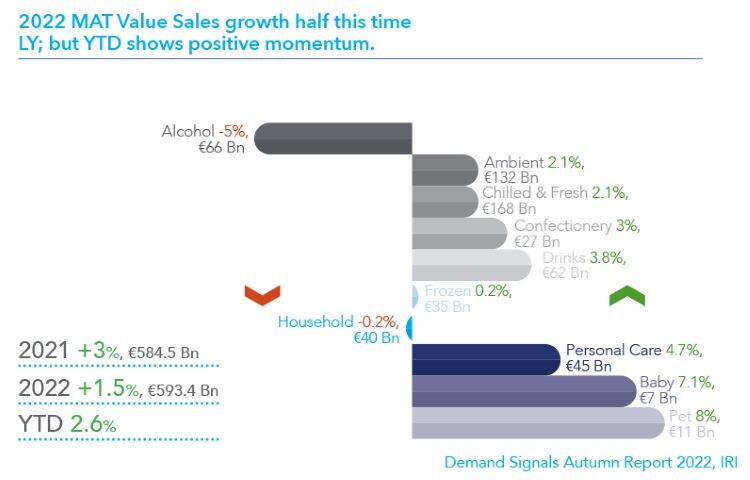
IRI’s biannual ‘FMCG Demand Signals’ report has forensically unpacks the impact of the pandemic and the current economically-stretched landscape and flags the deteriorating disposable income among middle and low-income consumers across the developed world. It analysed instore purchases of over 230 FMCG categories, 2,000+ product segments and over a 100 million SKUs across the US and several of the largest European (UK, France, Italy, Germany, Spain and Netherlands) and Asia Pacific markets.
According to IRI, growth in FMCG category sales has softened to 1.5% in 2022, adding €9bn in value sales versus a year ago – down from 3% in the previous year. However, it said the latest figures covering the year-to-date are promising at 2.6%, driven in large part by inflationary price increase rather than growing demand.
The contribution in growth from pent-up demand as restrictions eased, resurgent mobility from consumers returning to the office and taking holidays has faded. In fact, consumers are having to dip into personal savings to survive.
Categories fuelling 2022 growth have been identified as Chilled & Fresh, Ambient, Beverages & Personal Care products, however, this has been partially offset by declines in alcohol sales (5% drop) and household care (-0.2%) products.
“The ongoing slump in unit sales in response to inflation is an early indication of softness in FMCG demand,” said Ananda Roy, global SVP, Strategic Growth Insights, IRI.
“Unable to deliver every day lower pricing deals – and even maintain prices – because they’re experiencing higher input costs themselves, means brands and retailers need to look again at how they can support consumers throughout this very difficult period.
“We’re witnessing the biggest movement in consumer behaviour in over five decades, with shoppers questioning ‘Do I really need it?’, ‘Can we still afford to make a sustainable or altruistic choice?’ and now ‘Use less, waste less’.”
Consumers in crisis
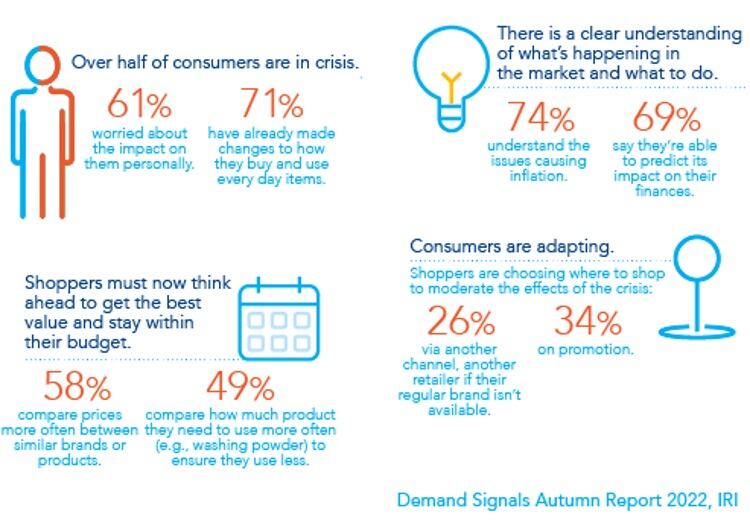
61% of Europeans surveyed say they are worried about the blow on them personally and 71% have already made changes to how they buy and use everyday items. 58% have cut down on essentials (driving to work or shop, missing meals and reducing heating) with 35% dipping into their personal savings and taking out loans to pay bills. Any money saved up over the pandemic has been drawn down to meet everyday living costs.
Consumers have begun to take control and be better informed of fast-moving changes in the economic environment. 74% surveyed say they understand the issues causing inflation, while 69% say they’re able to reasonably predict its impact on their day-to-day personal finances.
Shoppers are adapting to mitigate the impact of inflation across everyday food purchases. They are switching to Discounters that have expanded their stores into town centres and residential areas with a small but well-priced range of products at lower prices than the big retailers, but are also rooting out their favourite brands on promotion (34%) and choosing another retailer is their regular brand isn’t available (26%).
Planning in advance is becoming key, with 22% likely to make fewer trips to the shops and 21% spending less. 58% are also comparing prices more often, while 49% now comparing brands to calculate how much product they need to use to get better value and waste less.
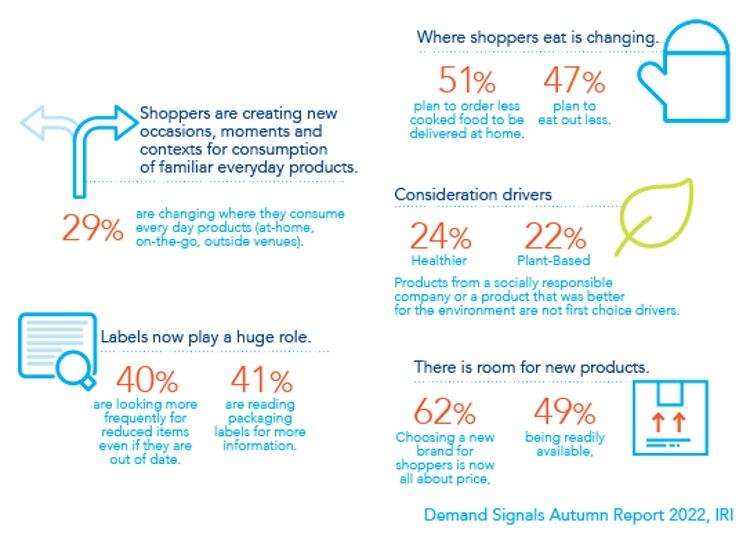
27% are reading independent reviews of everyday products – not only more expensive items – to justify a purchase, and 40% are looking more frequently for reduced items, even if they are slightly out of date.
Shoppers are creating new occasions and moments, with 29% serving up snacks at a stay in with friends rather than going out.
51% plan to order takeout less and 47% plan to eat out less. Cooking at home from scratch continues its pandemic-induced popularity among 49% of consumers. However, a new trend – harking back to previous generations and not culturally present in countries like the UK – is the return of cooking at home for out of home occasions like the return of the packed lunch (34%). 12% of mainly urban and professional consumer groups plan to rely on meal boxes and kits to cook at home despite the higher price.
Despite the forced austerity, many consumers are still willing to try something new, with 62% influenced by price (62%), availability (49%) and high levels of on-shelf promotion (37%). Less important is being of better quality (15%), innovative (8%) and about making shopping easier (8%). Consumers expect any new product on shelf to meet a retailer’s stringent standards, so going without saying is variety, quick commerce delivery for those staying in, and recyclable packaging and convenient sizes.
The better-for-you and plant-based trends are still very much alive, among 24% and 22% of consumers respectively. However, products from a socially responsible company or a product that is better for the environment often give way for the purchase drivers of availability at a good price and on promotion.
‘The tide has truly turned’
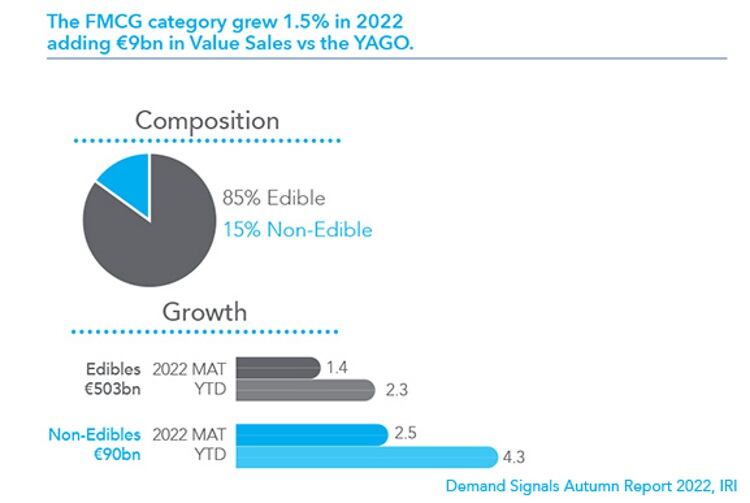
“It’s evident that consumers’ willingness to spend is suffering and the direction of travel is likely to worsen with the likelihood of further sharp price rises given high input costs and volatile energy price,” said Roy.
“But it’s positive to see that consumers are getting better informed and taking control, and adapting to cope better with a significantly constrained standard of living.
“Brand manufacturers and retailers who have fuelled the consumer’s expectation to receive the highest quality and innovation, round the year and out of season, at the lowest possible price are now unable to deliver – the tide has truly turned and a whole generation of consumers are experiencing a declining standard of living (not just a cost-of-living).
“Gone are the days of the one stop weekly shop, we’re expecting to see an increase in shopping around for must-have products and the consumption of less expensive seasonal goods. There are several difficult decisions for shoppers on the cards, and retailers and brands will do well to take a long and hard look at how they’re going to respond to shopper needs.”
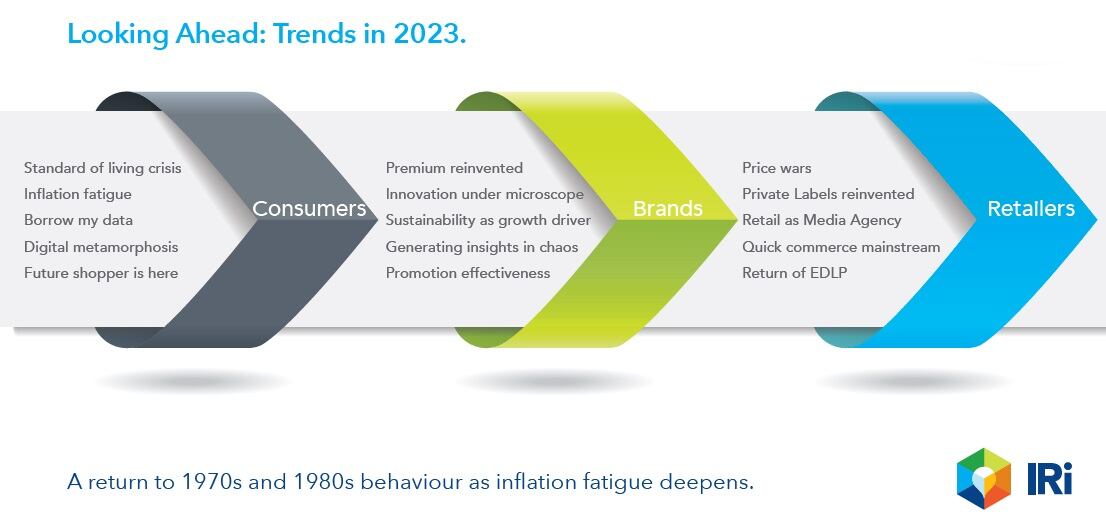
IRI’s ‘FMCG Demand Signals’ report describes value trends across channels, pricing and promotions of food and non-food categories, identifying growing and declining categories.
IRI’s data scientists study billions of transactions across the US and several of the largest European and Asia-Pacific markets to provide clarity on what drives commercial value.
The consumer behaviour insights originate from IRI’s ‘Crisis At Every Step’ inflation survey, which was conducted across 3,000 shoppers from the US, Australia, New Zealand, Brazil, Turkey, UAE, the UK, France, Spain, Germany, Italy and The Netherlands.



